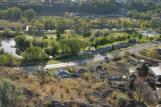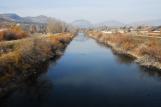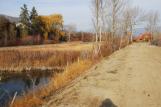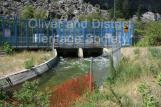36
However, as it evaporates, water can show us how quickly it is affected by the salinzation of our aquifers.37
Salinization from reclaimed water stains irrigated trees29 April 2007
Oliver, British Columbia, Canada
 Credits:
Credits:Russell Work
38
Urban sprawl and land development are destroying sagebrush habitat at an alarming rate; since the turn of the 20th century, it is estimated that over 60% of the habitat has been destroyed. Of the less-than-40% remaining, only 9% is relatively undisturbed original-state habitat. This less-than-3.6% exists as pockets scattered across the southern Okanagan, too small to support a stable ecosystem. As a result, over 400 plant and animal species are at risk of extirpation (local extinction).39
Sage and antelope brush ecosystem near Oliver16 May 2008
Oliver, British Columbia, Canada
 Credits:
Credits:Russell Work
40
The riparian wetlands are another habitat threatened by the industriousness of man. Not only are they disturbed by invading species, but the products of development also disturb their equilibriums easily. Pesticide runoff, construction, cattle, and intrusion by humans all change the balance of these delicate ecosystems.Studies estimate 85% to 99% of the riparian habitat is damaged.
41
Riparian area surrounding Okanagan River. Sagebrush in foreground.16 May 2008
Oliver, British Columbia, Canada
 Credits:
Credits:Russell Work
42
The single greatest contributor to wetland impact in the Oliver-Osoyoos area was the channelization of the Okanagan River. This project, completed in 1956, isolated the meandering oxbows of the river to give a more direct path, virtually eliminating 24km of slow-flowing riparian wetland.43
Channelization of the Okanagan River with dykes on either side, north of Oliver.17 November 2008
Oliver, British Columbia, Canada
 Credits:
Credits:Russell Work
44
Realizing the damage to the ecosystem, concerned citizens are now trying to restore some of the oxbows. The first phase of this project is anticipated to be complete in the Spring of 2009.Wetlands conservation is an important issue for the future because of the ecological stability and protection that they bring to the land. The meandering river path and root systems dampen erosion by reducing current speed and helping soil accumulation. Plants along the perimiter absorb phosphorus and nitrogen from the water, preventing algae blooms, and waste products distributed during flooding help to fertilize surrounding floodplains. Finally, although they do not have the flood protection that a channel offers, the porous nature of their shorelines has a buffering effect on water levels, shedding water during drought, and retaining water during heavy runoff.
45
Restoring the oxbows north of Oliver17 November 2008
Oliver, British Columbia, Canada
 Credits:
Credits:Russell Work
46
Another concern of overdevelopment within aquatic systems is the restriction of salmon spawnings. Ten dams, hydroelectric or flood control, lie between the Pacific Ocean and the Okanagan River's spawning areas. On top of that, reduced flow out of Osoyoos Lake raises temperatures in the river, reducing the spawning period for sockeye salmon. The installation of dams, combined with the raised temperatures and existing pollution have drastically reduced the volume of sockeye runs. Pre-1900 accounts place spawning numbers exceeding one million fish. A 1997 estimate places that year's spawning numbers around 30,000.The Okanagan Nation Alliance has been working hard to restore spawning salmon to the river through an intense fisheries project. In order to ensure that Salmon do not get lost on the way, the Town of Oliver has committed to a fish screen system at the intake dam for the Ditch. This screen is expected to cost nearly $1 million.
47
Spillway into Ditch at Pattullo Dam24 July 2008
Oliver, British Columbia, Canada
 Credits:
Credits:Sabyan, Gregory
48
In January, 2009, changing water standards highlighted the reliance Oliver has on reliable water sources. Acceptable levels of heavy metal uranium in drinking water were decreased by Health Canada from .1 to .02 milligrams per litre. As a result, two of the community's four drinking water wells had to be shut down. The concern at the time this exhibit was developed was how to meet anticipated increase in summertime demand. Addressing the Town's water needs became the highest priority for Town Council.49
Letter to editor regarding water quality28 September 2007
Osoyoos, British Columbia, Canada
 Credits:
Credits:Albo, A.J.
The Okanagan Sun